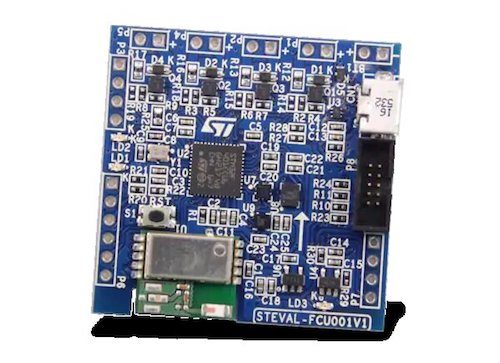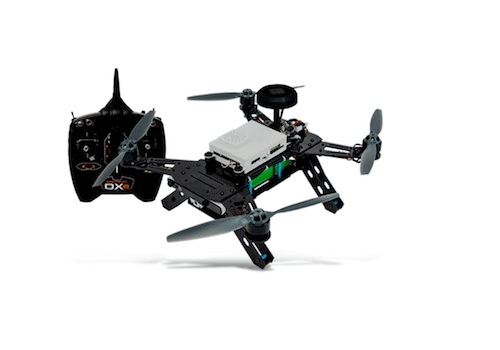Unmanned aerial vehicles (UAVs), often known as ‘drones’ or ‘quadcopters’, are one of those areas of technology that have been hitting the mainstream media in recent weeks and months. Concerned by potential misuse and the serious impact of this, many countries have recently enacted legislation covering where and how UAVs can be used, and training requirements for operators. Few can have missed the fact that an errant drone (or perhaps more than one) recently shut down the UK’s second airport for an extended period.
Originally, drones were mainly for military use, and that remains a significant area. However, the rapid growth of consumer technologies including smartphones has both advanced technology and driven cost reductions through volume, meaning that drones have now become popular in non-military applications.
Advances in other sectors, including sensors such as accelerometers, gyroscopes, image sensing and GPS, as well as wireless communications and battery technology, have together enabled a surge in drones at a price point that makes them attractive to small commercial users and consumers.
Drones are big business
According to research on behalf of Goldman Sachs, the combined value of the commercial, consumer and military drone markets will be around $100 billion by next year (2020). Gartner has segmented the markets further to show that consumer drones dominate unit sales in the non-military market, which represents 30% of the total market. In fact, by unit volume 94% of non-military drones shipped are to consumers, but the low prices mean that they represent less than half of the sales revenue. On the other hand, commercial drones (which can cost in excess of $10,000 each) are expected to be around 60% of non-military sales by value, despite being only 6% of non-military sales by volume.
The volumes in the consumer sector may appear to make it the most appealing market but, in reality, the commercial market seems to be the place to be. Many new use cases are being developed, fuelled by technological advances and the need to move from traditional approaches to cut costs. The commercial sector, as a result, has the fastest growth rates and, with the higher per-unit prices, this market is expected to be worth around $13 billion by next year.
Drones are enabling new business models and reducing costs in others, while making them safer and simpler. Aerial photography is being used far more in high-end real estate and to promote locations for tourism, as the costs have dropped due to not needing a helicopter or fixed-wing aircraft. No longer is a pilot and photographer needed; one person can do the job safely and quickly.
Drones are also permeating other sectors such as security and surveillance, insurance, farming, journalism and many more. When PwC analysed the markets, its report indicated that use in infrastructure represents the greatest opportunity, followed by farming/agriculture and then transportation.
As each day passes, new uses are found for drones, enabling companies to look at their businesses from a new perspective – often quite literally. Consultancy firm BCG expects the combination of the European and North American markets to comprise a fleet of over one million drones by 2050. Attached to this will be a market value of around $50 billion within the same time frame – and while hardware will remain important, over 50% of this market will be from drone-related services and data. Many new business opportunities will be created, with specialist drone firms offering surveying and photography services to other companies. Other unrelated businesses are expected to see potential and enter the sector – for example, telecom companies may offer the ability to relay drone data in real time across distances far greater than the drone itself can manage – or even facilitate long-distance remote control of drones.
Commercial uses for drones
The most heavily reported and often-discussed commercial use for drones has been their use for the delivery of small packages. In fact, to many people, this seems the most likely use apart from other military and consumer uses. However, there are still significant challenges related to parcel theft, as well as regulatory issues – and the ability of drones to carry some parcels. In fact, this is just one possible commercial application, and there are many more which will happen far sooner.
Inspection/Mapping
In the past, people had to be sent out to undertake inspections and, as many of these were in remote locations, there was a significant cost associated with this as well as some safety issues. However, drones are very capable of inspecting building roofs, solar panel installations, wind turbines, cellular infrastructure/masts, pipelines, railways, bridges, roads and much more. Specialist applications can benefit from equipping drones with high-definition (HD) cameras or even infra-red (IR) for certain uses. LIDAR technology can be used to map potential building sites to the nearest centimetre, delivering highly accurate planning in a fraction of the time of traditional approaches.
Archaeology is also benefiting from drone technology. No longer must archaeologists invest in a helicopter to get up-to-date views of potential dig sites – drones can do this quickly, easily and cheaply, and are often able to identify features not visible from the ground. Once the dig is in progress, drones can then document progress visually.
Infrastructure and agriculture
Drones are able to act as wireless access points, and can hover in remote locations to bring modern communications to very remote areas. This has potential uses in disaster management, such as an aircraft crash miles from anywhere, and also in adding additional communication capacity for popular sporting events or festivals – or anywhere large crowds are gathered and conventional capacity is stretched. Farmers are using swarms of meshed drones to seed remote areas, or to treat crops with fertiliser or pesticide. They are also being used to monitor open-grazing livestock and check on crops without the need to make a long journey – saving time and cost.
First responders and medical applications
Drones are being used in search-and-rescue operations to locate individuals who may be incapacitated or simply lost in a remote area. Often victims can be difficult or dangerous to reach by helicopter or on foot, so drones are being used to deliver medications, blood transfusions or medical devices to remote locations while first responders are on the way. In the USA, the Federal Aviation Administration (FAA) has seen the value and is starting to approve similar uses there.
There seems to be an ever-increasing number of wildfires, and drones are being deployed in the effort to contain these. Specialist drones that are able to resist the high temperatures involved are being used to survey areas affected by fire, enabling senior firefighters to plan a strategy while freeing up other firefighters to perform tasks only humans can, such as saving lives. For fires inside large buildings, highly specialised drones can be equipped with altimeters, inertial navigation units and even laser scanners to allow them to reach and scan areas before firefighters are deployed there – and they can also find survivors, enabling first responders to be directed to areas where they are most needed.
Entertainment and sports
Combining drones with LED technology is challenging traditional fireworks, as swarms of mesh-networked drones can now perform beautiful, computer-choreographed displays at major events – as seen at the recent Winter Olympics in Pyeongchang. Drones are also becoming a sport in themselves, with drone racing garnering enough attention to warrant multi-year television contracts. The demographics of the racers and the spectators are somewhat wider than with traditional sports, so this new sport is eliminating barriers and appealing to a very wide audience.
Developing drone technology
With the huge growth and business potential of the drone market there are many companies looking to develop drones, some for the first time. In order to capitalise on the opportunity, time to market is critical – yet, with the vast array of drone types being deployed, designing a drone can be daunting.
Manufacturers of the technology are supporting designers (both experienced and less experienced) through the provision of development platforms that mix established technology with a large number of customisation options. This gives a relatively low-risk way for designers to get a new drone design off the bench and into the air, quickly and with confidence.
Aimed at small to medium drone designs, STMicroelectronics’ STEVAL-FCU001V1 evaluation board is a compact flight controller (FCU) that is compatible with both brushed and brushless DC motors. The efficient design maximises battery life, while the included firmware significantly reduces development time and allows designers to assess a range of sensors during real flight conditions. Based on a 32-bit microcontroller, the board includes Bluetooth that allows smartphone/tablet control as well as the use of a standard RF controller to control the flight. The highly featured development kit also includes an accelerometer and gyroscope as well as pressure-sensing capability to enable sophisticated 3D navigation. Designers will benefit from the inbuilt SWD, I2C and USART connectivity when developing and debugging code, as well as the ability to use these connectors to add additional sensing capability.

Incorporating a 16-bit DCS, three-axis accelerometer and dual-axis gyroscopes, the DFRobot UAV V3 development platform can be used stand-alone to design a tri-axis IMU controller, and can be a fully-fledged UAV controller with the simple addition of a GPS module. Design times are reduced by the included self-testing firmware, which gives designers a platform on which to build their own application-specific code. For more advanced applications, autopilot software is available on an open-source basis.
Intel’s Aero Platform for UAVs from Intel is a fully integrated platform for smart drone applications that is intended for use by university staff and students as well as commercial drone developers. The Aero Ready-to-Fly drone kit includes computing, communication and sensor technologies in a fully tested, assembled and configured quadcopter drone. Intended to get designs off the bench and into the air quickly, central to the kit is the powerful Aero Compute Board. This board includes depth and vision capability from Intel’s RealSense technology that facilitates advanced algorithms for collision avoidance while in flight. The FCU includes a 32-bit microcontroller, IMU, magnetometer and altitude sensors, and provides a fully featured flight stack based on the included PX4 Autopilot software running under Linux. Not limited to the provided platform, designers can also create individual drones by matching the Aero Compute Board with the available three-camera Vision Accessory Kit and the Enclosure Kit that allows the technology to be physically attached to a wide variety of UAV airframes.









